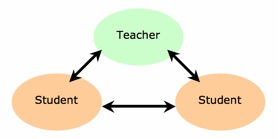You are here:
- Home
- Mathematics and statistics
- Assessment
- Formative assessment
Formative assessment occurs DURING learning
What this looks like in mathematics and statistics
Formative assessment enables a teacher to:
- provide students with feedback to improve and enhance learning
- understand student learning
- build a picture of student progress
- inform planning decisions, may involve further diagnosis
- adapt teaching to meet student learning needs.
Questions teachers and students should be asking:
- What are we trying to do?
- How well have we done it?
- How do we know?
- What do we do when we don’t know what to do?
Specific activities
- Students posing and answering questions.
- Students evaluating questions in a textbook exercise to decide which ones they should work on.
- Asking 'What is the same and what is different?', for example, for linear or quadratic functions.
- Asking students to 'find another example . . . and another', for example, a function has x-intercepts 3 and 5.
- Giving an A5 piece of scrap paper for students to record their thinking about what they learned, need to know, would like help with.
- Exit slips: Exit slips are a quick assessment tool for teachers to use as part of their daily classroom routine.
- The teacher poses a question for the students to respond to. The question must be short and shouldn’t take students long to complete.
- Students complete on a slip of paper or card.
- As the students leave the classroom they hand in their exit slip.
- The classroom teacher now has a quick assessment tool. By assessing the responses on the exit slips the teacher can better differentiate the instruction in order to accommodate students' needs for next lesson.
- Examples of exit slip questions:
- write one thing you learned today
- write one question you have about today's lesson
- of the 3 graphs we studied today, which one did you find most useful? Why?
- Using cooperative activities, for example, Get it Together, EQUALS.
- Using counter-examples to disprove conjectures, for example, every quadratic graph cuts the x-axis twice.
- Giving the answer and asking what is the question, for example, a quadratic equation has solutions ½ and 3, what is the equation?
- Self-assessment
- Peer-assessment
- Homework
- Lesson diagnostic snapshot, for example, ask the students questions such as: 'Find fractions between these pairs of fractions; and , and..'.
- Use of mini-whiteboards for students to show their answer to a question.
- Quiz at beginning of a lesson.
- Student generated test or practice examples.
Further information
-
Erickson, T. (1989). Get it Together: Maths Problems for Groups.
A resource for problem solving in groups where each member has a clue but cannot show it to the rest of the group.
- William, D. (2007). Ahead of the Curve: The Power of Assessment to Transform Teaching and Learning. Content then process: Teacher learning communities in the service of formative assessment.
Last updated September 17, 2018


